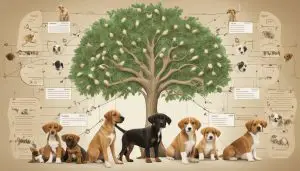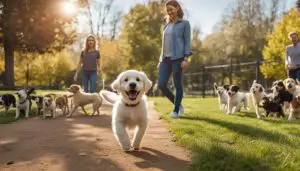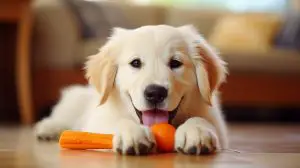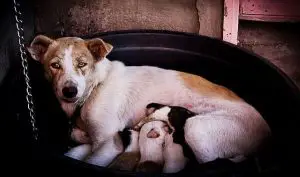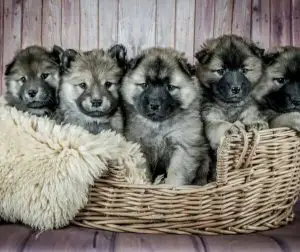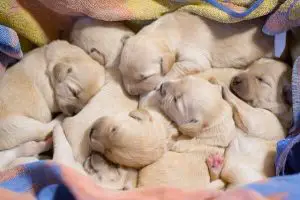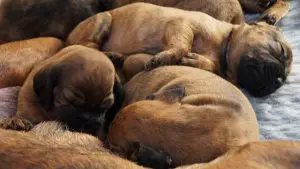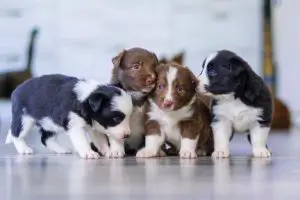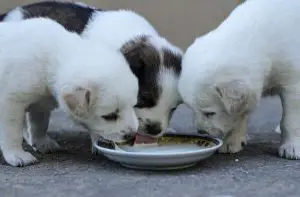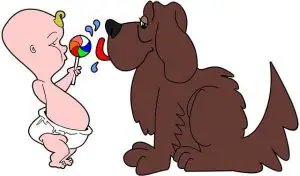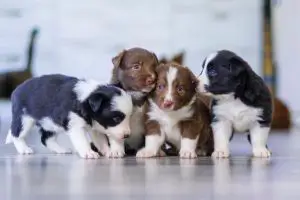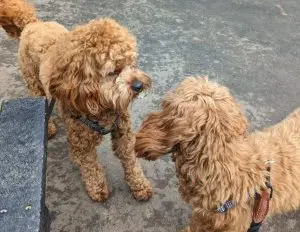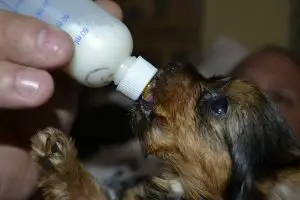Have you ever noticed a striking resemblance between your new puppy and their grandparents? Perhaps they share the same colouring or have similar facial features? It's not uncommon for puppies to resemble their grandparents, and in this article, I will explore the fascinating topic of whether this is possible and why it happens.
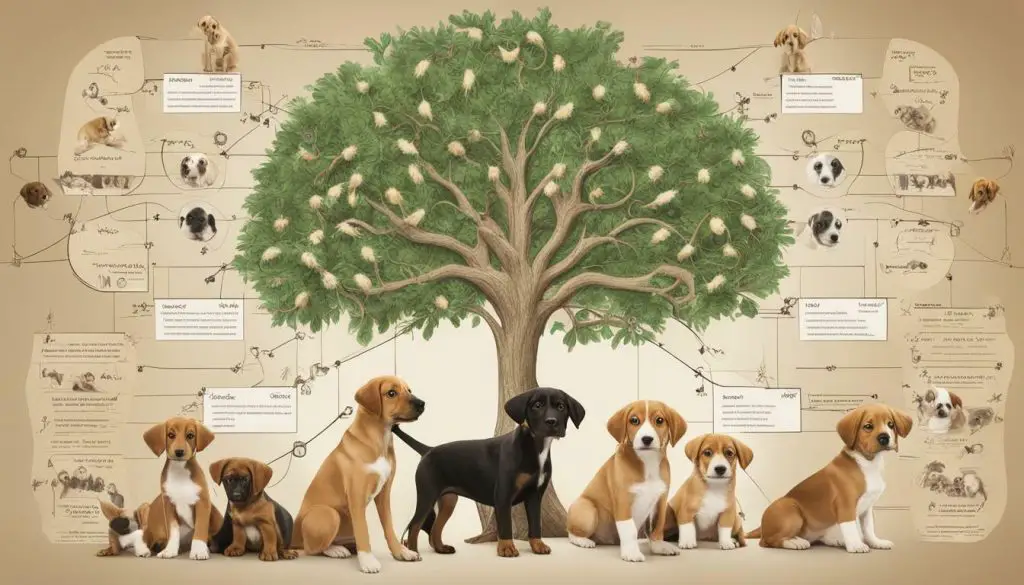
We will delve into the world of genetics and uncover the secrets behind puppy resemblance to their grandparents. We will also discuss the role that environmental factors play in a puppy's appearance. By the end of this article, you'll have a deeper understanding of why some puppies have a family resemblance!
Key Takeaways
- Puppies can inherit physical traits from their grandparents through genetics
- Hereditary traits play a significant role in determining puppy appearance
- Environmental factors can also affect a puppy's physical appearance
- Real-life examples show that it is possible for puppies to strongly resemble their grandparents
Table of Contents
- Understanding Hereditary Traits in Dogs
- Exploring Puppy Resemblance to Grandparents
- Genetic Variation and the Role of Ancestry
- Environmental Factors and Their Impact
- Case Studies: Real-Life Examples of Puppy Resemblance
- Conclusion
- FAQ
- Q: Can puppies inherit physical traits from their grandparents?
- Q: What are hereditary traits in dogs?
- Q: Why do some puppies resemble their grandparents?
- Q: How do genetics play a role in puppy appearance?
- Q: Can environmental factors affect puppy appearance?
- Q: Are there any real-life examples of puppies resembling their grandparents?
- Read my latest puppy articles here:
Understanding Hereditary Traits in Dogs
Have you ever wondered why certain physical traits seem to run in families, even in dogs? The answer lies in the concept of hereditary traits.
Hereditary traits are characteristics passed down from parents to their offspring. In the case of dogs, these traits can also come from grandparents and other ancestors, making the inheritance pattern more complex than in humans.
Hereditary traits are determined by genes, units of heredity that contain information about physical traits. Each dog has two copies of each gene, one from each parent. Some genes have dominant and recessive forms, with dominant genes being expressed over recessive ones.
When a puppy is born, it inherits a combination of genes from its parents and ancestors, including grandparents. This combination can determine many physical traits, such as coat colour, eye colour, and size.
Understanding the Mechanisms of Inheritance
There are different ways in which hereditary traits can be passed down from one generation to another. The most common are:
- Simple Mendelian inheritance: This type of inheritance follows the patterns described by Gregor Mendel in the mid-19th century. It involves one gene with two different versions, one of which will dominate over the other. For example, if a dominant gene for black coat colour is present, it will mask the recessive gene for brown coat colour. Simple Mendelian inheritance is relatively rare in dogs, but it can occur for certain traits, such as hip dysplasia.
- Complex inheritance: This type of inheritance involves multiple genes and environmental factors that influence the expression of traits. Many physical traits in dogs, including size, shape, and some health conditions, are inherited through complex inheritance.
- Epigenetics: This is the study of how changes in gene expression can occur without changes in the DNA sequence. Epigenetic changes can be influenced by environmental factors, such as nutrition and stress, and can be passed down through generations.
Understanding these mechanisms of inheritance can provide insight into why some puppies resemble their grandparents in physical appearance.
Exploring Puppy Resemblance to Grandparents
Have you ever wondered why some puppies look similar to their grandparents? As we have learned in previous sections, genetics play a significant role in determining a puppy's physical appearance. However, there are other factors that contribute to puppy resemblance to their grandparents.
Family resemblance in puppies can be attributed to shared genetic material, as well as the transmission of specific traits through generations. For example, if a grandparent has a dominant trait for a particular feature, such as a curly coat, there is a greater chance that their grandpups will also inherit that trait. On the other hand, if a grandparent has a recessive trait for a feature, such as a straight coat, the likelihood of that trait being expressed in future generations is reduced unless both parents carry the recessive gene.
Additionally, it is important to note that not all traits are inherited in the same way. Some traits, such as coat colour, are controlled by a single gene, while other traits, such as size and shape, are controlled by a combination of multiple genes. Therefore, the specific traits that are passed down from grandparents to puppies can vary depending on the genetic makeup of the grandparents and the parents.
Overall, puppy resemblance to grandparents is a result of various genetic factors. By understanding these mechanisms, we gain insight into why some puppies may look similar to their grandparents and appreciate the complexity of inheritance in dogs.
Genetic Variation and the Role of Ancestry
When it comes to puppy appearance, genetics plays a crucial role. The combination of genetic material from both parents can result in a wide range of physical traits in their offspring. However, the role of ancestry doesn't stop there. Grandparents also play a significant role in determining a puppy's appearance.
The transmission of specific traits through generations is a fascinating process. For example, if a puppy's grandparent had a distinctive coat pattern, there is a chance that the puppy will inherit that pattern. Furthermore, certain genetic mutations can remain dormant for generations and suddenly resurface in a puppy.
| Example: | If a grandparent had a mutation that caused a bobtail, and both parents carry that gene, there is a chance that their offspring will inherit the bobtail. |
|---|
Additionally, it's important to consider the influence of genetic variations. Not all puppies with the same grandparents will look the same. Genetic variation can lead to significant differences in appearance, even between siblings.
Therefore, while ancestry plays a significant role in puppy appearance, it is not the only factor. The interaction of genes from both parents and environmental factors can also have a profound impact on how a puppy develops.
Environmental Factors and Their Impact
It's no secret that genetics play a significant role in determining a puppy's physical appearance. However, it's important to remember that environmental factors can also have an impact. Here are a few examples of how the environment can affect a puppy's appearance:
- Diet: Just like with humans, a balanced diet is essential for a puppy's overall health. Nutrient deficiencies or imbalances can affect everything from coat quality to eye color.
- Exercise: Regular exercise is crucial for a puppy's physical development. Not enough exercise can lead to excess weight and a lack of muscle tone, while too much exercise can cause joint problems and stunted growth.
- Health: A puppy's overall health can impact their physical appearance. Illnesses, infections, or injuries can affect everything from their coat to their eyes. It's important to keep your puppy up-to-date on all necessary vaccinations and regular vet check-ups.
While these environmental factors do not directly affect inherited traits, they can influence the expression of those traits. For example, a puppy who inherits the gene for a thick coat may not develop that coat fully if they are malnourished or not getting enough exercise.
Overall, it's important to remember that inherited traits are only part of the equation when it comes to a puppy's appearance. Environmental factors can also have an impact and should not be ignored when considering why a puppy may or may not resemble their grandparents.
Case Studies: Real-Life Examples of Puppy Resemblance
As a professional copywriting journalist, I have come across numerous interesting stories of puppies resembling their grandparents. Here are a few real-life cases to illustrate the fascinating concept of inherited traits in dogs:
"My neighbour's puppy looked almost identical to his granddad. The colouring, the facial features, even the way he played with his toys – it was like watching a mini version of his grandfather in action!"
This quote from a dog owner showcases the striking resemblance that can exist between puppies and their grandparents. Even small details such as the way they play can be inherited through generations.
In another case, a breeder shared her experience of breeding a litter of puppies with striking resemblance to their grandparents:
"When I bred a litter of pups from a female dog and a male dog, both of whom had very distinctive physical traits, I was amazed to see those traits passed down to the puppies. One of the pups was the spitting image of his grandfather, with the same broad chest and muscular build."
Through this example, we can see how specific physical traits can be inherited and expressed in future generations.
Another interesting story comes from a dog owner who noticed the similarities between her puppy and his grandparents despite some differences:
"My puppy definitely takes after his grandparents in terms of his facial features, but he has a completely different coat colour. It's fascinating to see how traits can be inherited but also modified through subsequent generations."
This example highlights the role of environmental factors such as diet and health in potentially modifying inherited physical traits.
Overall, these case studies demonstrate the potential for puppy resemblance to grandparents and the fascinating intricacies of inherited traits in dogs.
Conclusion
After thorough exploration into the topic of whether puppies can resemble their grandparents, I have discovered that it is indeed possible. Through an understanding of genetics, hereditary traits, and environmental factors, it is clear that physical resemblance can be passed down through generations.
While genetics play a significant role, it is important to remember that environmental factors can also impact a puppy's appearance. Proper diet, exercise, and overall health can contribute to a puppy's physical traits, even if they share genetic similarities with their grandparents.
Through real-life case studies, we have seen the various ways physical traits can be inherited and passed down through generations. From coat color to facial structure, there is a potential for puppies to bear a striking resemblance to their grandparents.
So, if you find yourself with a furry friend who looks similar to their grandparents, don't be surprised – it's all in the genes! Remember to give your puppy the love and care they deserve, and appreciate their unique features that make them who they are.
FAQ
Q: Can puppies inherit physical traits from their grandparents?
A: Yes, puppies can inherit physical traits from their grandparents. Genetic material from both parents, including the genes passed down from the grandparents, can contribute to the physical appearance of puppies.
Q: What are hereditary traits in dogs?
A: Hereditary traits in dogs are characteristics that are passed down from one generation to another through genetic inheritance. These traits can include physical features, temperament, and health conditions.
Q: Why do some puppies resemble their grandparents?
A: Puppy resemblance to grandparents can be attributed to shared genetic material and the transmission of specific traits through generations. The combination of genetic material from both parents, as well as the influence of the grandparents' genes, can contribute to the physical traits observed in puppies.
Q: How do genetics play a role in puppy appearance?
A: Genetics play a significant role in determining puppy appearance. The combination of genetic material from both parents, along with the influence of the grandparents' genes, can contribute to the physical traits observed in puppies. Genetic variation and the role of ancestry are important factors to consider when understanding puppy resemblance to grandparents.
Q: Can environmental factors affect puppy appearance?
A: Yes, environmental factors can affect puppy appearance. While genetics play a significant role in determining physical traits, factors such as diet, exercise, and overall health can also impact a puppy's appearance. It's important to consider both genetic and environmental factors when discussing puppy resemblance to grandparents.
Q: Are there any real-life examples of puppies resembling their grandparents?
A: Yes, there are real-life examples of puppies resembling their grandparents. Through case studies, we can see how physical traits can be inherited and passed down through generations. These examples provide concrete evidence of the potential for puppy resemblance to grandparents.
Read my latest puppy articles here:
- Can Puppies Look Like Their Grandparents? Unravelling the Mystery!Have you ever noticed a striking resemblance between your new puppy and their grandparents? Perhaps they share the same colouring or have similar facial features? It's not uncommon for puppies to resemble their grandparents, and in this article, I will explore the fascinating topic of whether this is possible and why it happens. We will… Read more: Can Puppies Look Like Their Grandparents? Unravelling the Mystery!
- When Do Puppies Require Less Supervision? A Detailed Guide.As a new puppy owner, it's important to keep a close eye on your furry friend. Puppies are curious and energetic, which means they require constant supervision to stay safe. However, as your puppy grows and develops, they will start to become more independent and require less supervision. But when exactly do puppies require less… Read more: When Do Puppies Require Less Supervision? A Detailed Guide.
- Can Puppy Eat Salmon? – A Friendly Guide to Feeding PuppiesWelcome to our friendly guide on whether it is safe for a puppy to eat salmon. As a pet owner, you want to ensure that your furry friend is receiving the best possible nutrition to support their well-being. Salmon is a nutritious fish that provides several health benefits for dogs, but is it safe for… Read more: Can Puppy Eat Salmon? – A Friendly Guide to Feeding Puppies
- Carrots for Puppies Teething: A Natural Solution for Pain ReliefWhen your little furry friend is going through the teething process, it can be a challenging time for both of you. Thankfully, there are natural remedies that can help relieve their pain while promoting overall health. One such remedy is carrots for puppies teething. Carrots are an excellent source of vitamins and minerals that can… Read more: Carrots for Puppies Teething: A Natural Solution for Pain Relief
- How long do puppies need milk?Puppies typically need milk as their primary source of nutrition until they are around 4 to 6 weeks old. After that, they can gradually transition to solid food, but it's essential to consult a vet for guidance on the appropriate time to introduce solids to ensure the puppies' needs are met. Welcoming a litter of… Read more: How long do puppies need milk?
- Can ultrasound be wrong about puppies?Yes, ultrasound can sometimes be wrong about the number of puppies expected. Factors like foetal position, maternal tissue interference, or early gestation can affect the precision of the ultrasound results. Check with a vet for the most accurate assessment. Bringing new puppies into the world is an exciting time for dog owners and breeders. One… Read more: Can ultrasound be wrong about puppies?
- Why does a mother dog lay on her puppies?A mother dog lays on her puppies to provide warmth, comfort, and security. This behaviour is promoted by the release of oxytocin and prolactin, which awaken a mother’s protective instincts. Laying on her puppies helps regulate their body temperature and promotes bonding. When a dog mum gives birth to puppies, it’s a super exciting time,… Read more: Why does a mother dog lay on her puppies?
- Do puppies have rabies when they are born?No, puppies are not born with rabies. Rabies is a viral disease transmitted through the bite of an infected animal or, very rarely, through a mother’s milk if the mother carries the disease. It's crucial to vaccinate puppies to protect them from this potentially deadly disease. In the rest of this piece, we’ll explore if… Read more: Do puppies have rabies when they are born?
- Do puppies stop moving before birth? Yes, absolutely puppies often do stop moving before birth. Later in pregnancy, puppies are likely to move more to get into the proper position for delivery. After that, puppies usually settle and stop moving. Preparing for the birth of new puppies can be as challenging as it is exciting. You know there’ll be cuteness in… Read more: Do puppies stop moving before birth?
- What do breeders do with unsold puppies?When ethical breeders have unsold puppies, they may explore various options such as advertising, reducing prices, or giving them more training. They may also seek reputable homes through adoption, or work with rescue organisations to ensure the puppies find suitable, loving homes. Breeding can be tremendously rewarding. With litters of anywhere from a single pup… Read more: What do breeders do with unsold puppies?
- Do puppies bark more when teething?Yes, puppies do bark more when teething. The discomfort and pain caused by teething can lead to increased restlessness and irritability, making them bark more often. You can use teething toys and soothing remedies to help relieve their discomfort and curb their barking. Puppies are known for their adorable antics and playful nature. You may… Read more: Do puppies bark more when teething?
- When do puppies become affectionate? Puppies start showing affection as early as a few weeks old. However, the timing depends on their personalities, socialisation, and bond with their owners. Most puppies develop increasing affection as they grow and form stronger emotional connections with their owners. Just as with us humans, puppies go through emotional development as they grow. In their… Read more: When do puppies become affectionate?
- Is birch tree milk good for puppies? The benefits of birch tree milk for puppies are not well known, though the answer is yes, in moderation. If in doubt, it’s best to provide them balanced commercial puppy food formulated to meet their specific nutritional needs to keep your pup healthy. Puppies are bundles of joy. I can testify to that fact because… Read more: Is birch tree milk good for puppies?
- Can you use puppy pads for babies?While not toxic to babies, puppy pads are designed for training puppies to do their business indoors and should not generally be used for babies. Instead, use specialised baby changing pads that are safe and hygienic. It may seem an outlandish idea to use puppy pads for babies, because we all know how important it… Read more: Can you use puppy pads for babies?
- Do puppies lose weight after birth?Unravel the mystery: Do puppies lose weight after birth? Learn about newborn puppy care and weight gain essentials. Start your puppy parenting journey here! As a new breeder or a pet owner, you might be wondering, "Do new-born puppies lose weight after birth?" This is a common question, especially for those who are new to… Read more: Do puppies lose weight after birth?
- Do puppies joints click?Do Puppies Joints Click? Exploring the Truth Puppy joint-clicking is a common occurrence in many breeds. But, it could be a sign of underlying health issues. To understand why it happens and how it affects their health, we need to know more. Joint clicking in puppies can have various causes. Stiffness or discomfort with consistent… Read more: Do puppies joints click?
- Why is milk coming out of puppies nose?Explore the reasons why is milk is coming out of your puppies nose, understand its implications on canine health, and learn safe feeding techniques. Imagine cradling your adorable new puppy, feeding it a bottle, and suddenly you see milk trickling out of its nose. Alarming? Yes. Unique? Not quite. It’s a phenomenon that's more common… Read more: Why is milk coming out of puppies nose?
- When can you hear puppies heartbeat with a stethoscope?Introduction to Puppies' Heartbeat Have you ever heard the beat of a pup's heart? It can be detected with a stethoscope by 4-5 weeks into pregnancy! As time passes, the heartbeat becomes louder and more audible. It's essential to have regular vet check-ups during pregnancy, to monitor the heartbeat. Plus, this can also help spot… Read more: When can you hear puppies heartbeat with a stethoscope?
- Does birth order matter in puppies?Explore, does birth order matter in puppies, regards personality, temperament and dominance. See my research, and opinion so you can love 'em, quirks and all! To understand the importance of birth order in puppies, delve into the impact on socialization, the effects on temperament, and the influences on dominance. By examining these sub-sections, you start… Read more: Does birth order matter in puppies?
- Puppy Yoga: The latest fitness trend for animal loversWhat is puppy yoga? The latest craze in the pet world is "Puppy yoga", it's a type of yoga that involves practicing yoga poses and exercises with a dog as a partner or prop. It is playful and fun, less "zen" than a normal yoga class but in my opinion far more enjoyable. It is… Read more: Puppy Yoga: The latest fitness trend for animal lovers
- Why do Dogs Lick Blankets? When you bring home your new pup, it’s an absolute joy. You’ll soon find that you both have some challenges ahead of you though, ranging from training your dog to potty train, to helping him get used to sleeping downstairs at night. Here though we discuss something you may not have thought about it until… Read more: Why do Dogs Lick Blankets?
- Leaving Your Dog Downstairs at NightShould you leave your dog downstairs at night? The simple answer is yes, you really should. New puppies are so adorable but remember when fully grown it will not be so convenient to have them sleeping in your room and heaven forbid on your bed. So no matter how heart breaking it might seem to… Read more: Leaving Your Dog Downstairs at Night
- Are puppy pads a good idea?Puppy pads, a great tool for potty training your pup. They're absorbent, easy to clean, and provide a designated pee pad area for them to relieve themselves. I strongly recommended them. However, there are also some downsides to using them so in this article I try to give a balanced view on potty pad training!… Read more: Are puppy pads a good idea?
- How to Stop a Puppy From Biting: Tips and TricksPuppy biting can be a real problem. It's cute when they are little, but it can become a real issue when they get older. Not only is it annoying, but it can also be dangerous if the puppy starts to nip at people's hands and faces. See tips and tricks and learn how to stop… Read more: How to Stop a Puppy From Biting: Tips and Tricks
- Do Puppies Sleep More When Teething?Puppies love their sleep, with some sleeping for as much as 20 hours a day, only waking to eat and play. But what about when your pup is teething? How can this affect their sleep? Does the discomfort of their adult teeth coming through keep them awake? Puppies tend to sleep a little more when… Read more: Do Puppies Sleep More When Teething?

